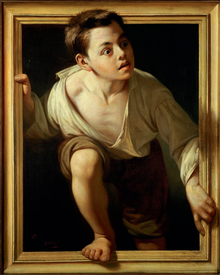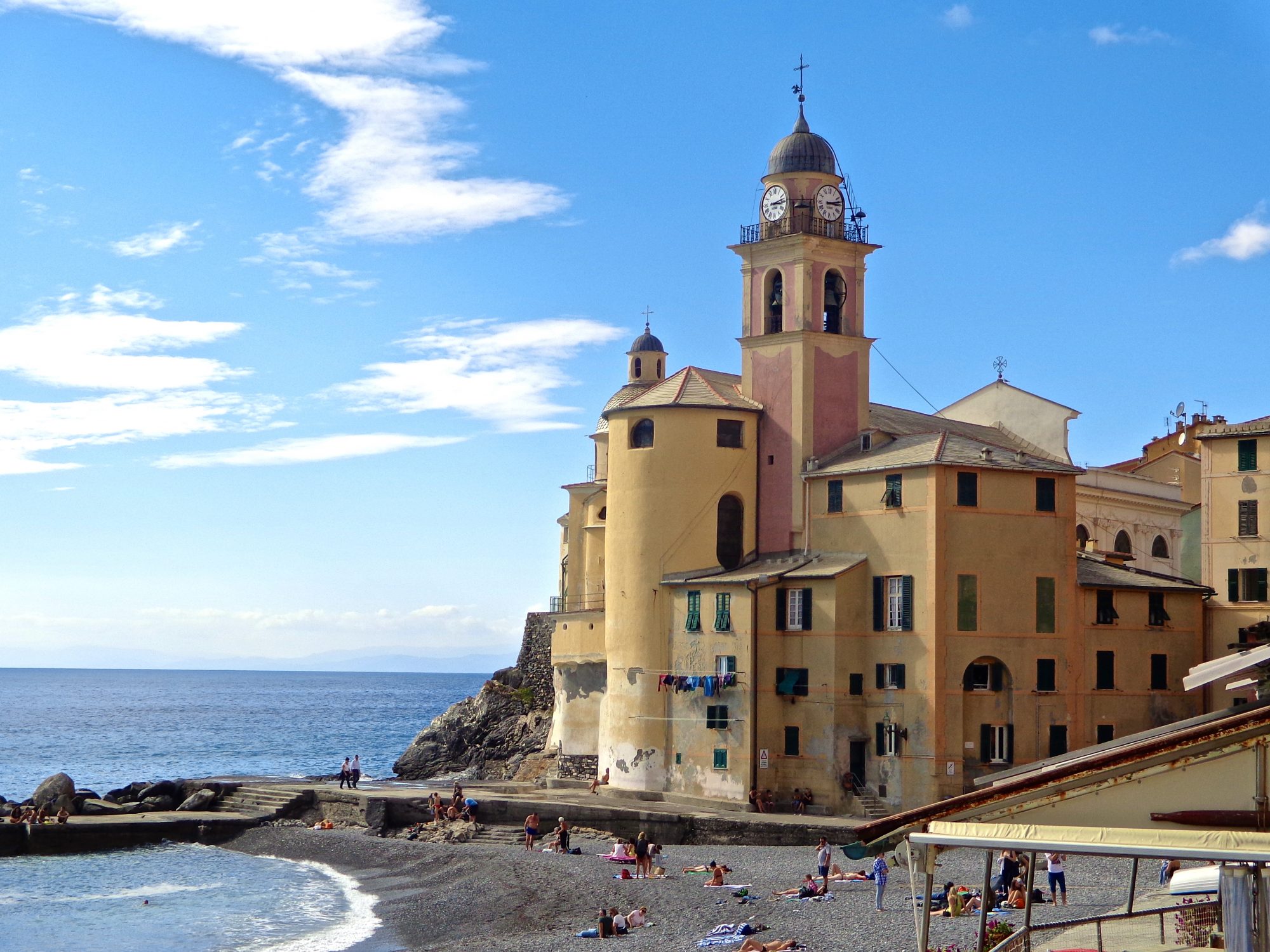
The Italian Riviera is one of my favorite places on earth. Beginning from Genoa and running south along the coastline to Portovenere, small towns along the way are a delight to explore. Camogli, Nervi and Santa Margherita are a few of the exceptional little villages that delight and charm. But they have another unique attraction that is most outstanding. Many of their houses and villas are painted with gorgeous exterior decoration. Caught up in this fascination with illusion, I spent a good amount of time seeking them out.

While walking through the maze of streets in these villages just this last September, several tall narrow houses caught my eye as being especially ornate. When I looked closer I was stunned to realize that some of the upper story windows were actually painted-on. Other houses had painted-on shutters, window frames, fancy stencil work around windows and even flowering window boxes. I had never seen anything like this before, and so I needed to investigate.
I researched further and found that corner stones were often painted-on where there weren’t any, washing lines full of clothes and even birds nests up high near the roof. Unbelievable, yet so detailed that it was difficult to tell what was real.

There are interesting historical ways of thinking in these communities that have made a tradition of decorative illusionism. Since the Renaissance, painted illusions creating optical tricks were popular especially in northern Italy. The Ligurians in particular used cosmetic exterior decoration on their facades to create an illusion of beauty.
Many of the houses in Liguria were built tall and narrow because of space restrictions. Several share exterior walls and remain attached in a continuous line. But the Ligurians have a reputation of being a pragmatic people, so by painting on windows, shutters and all kinds of adornments, they were able to dress up their homes without the added cost. They knew just how to dazzle the eye with charming appeal by elegant artistry.

This top row of windows could be painted-on. The use of shading created incredible 3-D effects that makes it difficult to know for sure.

It’s not unusual to see painted garlands gently hanging below a roofline, colorful ribbons over doorways, arches, porticoes, and curlicues. Like a blank canvas, the houses were bedecked and embroidered in the most attractive styles. I never saw two that looked just alike.

Evidently trompe l’oeil was first used by the ancient Greeks and then by Roman muralists. During the early Renaissance, false frames were painted depicting still life or portraits spilling out of them, and window-like images were painted on walls and ceilings that appear as actual openings.


These two paintings, for example, depict the same effect as the house facades do. By using innovative painting techniques, a flat surface comes to life by creating a sense of depth, and the eye is tricked. Notice the little cherubs standing on the rim and the faces gazing downward. The bucket balancing on the pole is very effective.
Even the frame is painted to complete this visual effect of the boy crawling out of the frame. By looking at these examples of trompe l’oeil, it begins to explain how these house facades particular to the Italian Riviera are achievable.
To this day, as I re-visit Camogli and the other surrounding villages on the Riviera, I gravitate to any charming house gaily decorated and take a closer look. And sure enough, those painted-on windows, cornerstones, curlicues and embellishments are truly exquisite.

Related Article:

Reblogged this on Conversational Italian!.
LikeLike
Wonderful blog about the unique buildings in the Italian Riviera. Such wonderful architecture is not to be missed! Will reblog this for November 2017 of Conversational Italian!
LikeLiked by 1 person
Hi, and thank you so much!!
LikeLiked by 1 person
Prego! Have it scheduled to post at the end of November, after Thanksgiving. Keep in touch!
LikeLiked by 1 person
Wonderful! Will do, thanks:)
LikeLike
Your style is unique compared to other folks I have read stuff
from. Thanks for posting when you’ve got the opportunity, Guess I’ll just
bookmark this page.
LikeLike
Or better yet, follow along. Love the company:)
LikeLike
Hi Susan, I was led here by Pat who left your link on my blog post about Parisian windows. I posted a photo of a building covered with painted murals of windows and she thought I would enjoy seeing your post! I do indeed, this post is simply beautiful, how incredible! I have never been to the Italian Riviera but would love to after visiting you here! 🙂
LikeLike
Hi Sherri, thank you for reaching out. I found this subject so intriguing. I remember seeing my first trompe l’oeil on a building and being just amazed. It looked so real. Your post about the Parisian windows is fascinating and I enjoyed reading it. Thank you for coming across my path!
LikeLike
Thanks so much Susan, I will definitely be back to take another look at your wonderful blog very soon 🙂
LikeLike
Sherri, i’m glad our paths crossed!
LikeLike
Me too Susan 🙂
LikeLike
Susan and Sherri – I’m glad you guys crossed paths and have come across similar paintings on buildings. Sounds wonderful to experience the same type of thing and compare notes.
LikeLike
Hi Pat, thank you for arranging this. It was a pleasure meeting Sherri and reading her post. She writes very well and I enjoyed learning a lot from her. You’re a sweetheart, Pat!
LikeLike
You’re truly welcome, Susan, and I hope you have many tales to exchange. 🙂
LikeLike
thank you Pat
LikeLike
🙂
LikeLike
http://commons.wikimedia.org/wiki/File:Trompe_l%27oeil._Antony_%2892%29.jpg is taken in Antony, in the suburbs of Paris !
LikeLike
Yes, you are quite right! I should have been clearer under the photo that it was NOT taken in Camogli, but in Paris. Thank you for bringing this to my attention. I have made this clear under the photo in the article.
LikeLike
Thank you, Susan — I shared. You’ve taken me on another interesting adventure. I never would have thought those buildings would have had windows painted on them.
LikeLike
Hi Pat, thank you for the comment. Yes, I was astounded when I discovered it. I guess I never had seen it before. I found that I had to get up close to figure them out. It was really fun! Have a great week
LikeLike